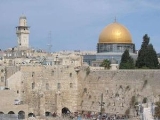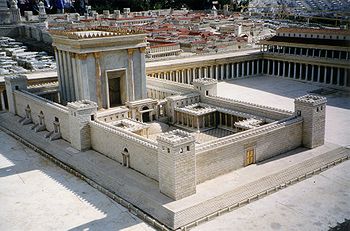
Jesus and the Money Changers
Encyclopedia
The narrative of Jesus and the money changers, commonly referred to as the cleansing of the Temple, occurs in all four canonical gospels of the New Testament
.
In this episode Jesus and his disciples travel to Jerusalem for Passover
, where he expels the money changers from the Temple
, accusing them of turning the Temple to a den of thieves through their commercial activities. In the Gospel of John
Jesus refers to the Temple as “my Father’s house” thus in some views making a claim to being the Son of God
.
This is the only account of Jesus using physical force
in any of the Gospels. The narrative occurs near the end of the Synoptic Gospels
(at , , , and ) and near the start in the Gospel of John
(at ). Some scholars believe that these refer to two separate incidents, given that the Gospel of John includes more than one passover.
is stated to have visited the Temple in Jerusalem
, Herod's Temple, at which the courtyard is described as being filled with livestock
and the tables of the money changers, who changed the standard Greek
and Roman
money for Jewish
and Tyrian money. Jerusalem was packed with Jews who had come for Passover, perhaps comprising 300,000 to 400,000 pilgrims
.
Creating a whip
from some cords, “he drove them all out of the temple, with the sheep and the oxen, and poured out the changers’ money and overturned the tables. But he said to those who sold doves, ‘Get these out of here! Do not make My Father’s house a house of merchandise!’”
 In John, this is the first of the three times that Jesus goes to Jerusalem
In John, this is the first of the three times that Jesus goes to Jerusalem
for the Passover
, and John says that during the Passover Feast there were (unspecified) miraculous signs performed by Jesus, which caused people to believe in his name, but that he would not entrust himself to them, for he knew all men.
In and Jesus again accuses the Temple authorities of thieving and this time names poor widows as their victims going on to provide evidence of this in and . Dove sellers were selling doves that were sacrificed by the poor who could not afford grander sacrifices and specifically by women. According to , Jesus then put an embargo on people carrying any merchandise through the temple—a sanction that would have disrupted all commerce.
Matthew
says the Temple leaders questioned Jesus if he was aware the children were shouting Hosanna
to the Son of David, and Jesus responded by accepting the worship of the children as valid by quoting "from the lips of children and infants you have ordained praise" from the Book of Psalms
.
 The Temple cleansing episode in the Gospel of John
The Temple cleansing episode in the Gospel of John
can be correlated with non-biblical historical data sources to obtain an estimate for the year to which the episode refers.
New Testament
The New Testament is the second major division of the Christian biblical canon, the first such division being the much longer Old Testament....
.
In this episode Jesus and his disciples travel to Jerusalem for Passover
Passover
Passover is a Jewish holiday and festival. It commemorates the story of the Exodus, in which the ancient Israelites were freed from slavery in Egypt...
, where he expels the money changers from the Temple
Temple in Jerusalem
The Temple in Jerusalem or Holy Temple , refers to one of a series of structures which were historically located on the Temple Mount in the Old City of Jerusalem, the current site of the Dome of the Rock. Historically, these successive temples stood at this location and functioned as the centre of...
, accusing them of turning the Temple to a den of thieves through their commercial activities. In the Gospel of John
Gospel of John
The Gospel According to John , commonly referred to as the Gospel of John or simply John, and often referred to in New Testament scholarship as the Fourth Gospel, is an account of the public ministry of Jesus...
Jesus refers to the Temple as “my Father’s house” thus in some views making a claim to being the Son of God
Son of God
"Son of God" is a phrase which according to most Christian denominations, Trinitarian in belief, refers to the relationship between Jesus and God, specifically as "God the Son"...
.
This is the only account of Jesus using physical force
Use of force
The term use of force describes a right of an individual or authority to settle conflicts or prevent certain actions by applying measures to either: a) dissuade another party from a particular course of action, or b) physically intervene to stop them...
in any of the Gospels. The narrative occurs near the end of the Synoptic Gospels
Synoptic Gospels
The gospels of Matthew, Mark, and Luke are known as the Synoptic Gospels because they include many of the same stories, often in the same sequence, and sometimes exactly the same wording. This degree of parallelism in content, narrative arrangement, language, and sentence structures can only be...
(at , , , and ) and near the start in the Gospel of John
Gospel of John
The Gospel According to John , commonly referred to as the Gospel of John or simply John, and often referred to in New Testament scholarship as the Fourth Gospel, is an account of the public ministry of Jesus...
(at ). Some scholars believe that these refer to two separate incidents, given that the Gospel of John includes more than one passover.
Description
In this episode, JesusJesus
Jesus of Nazareth , commonly referred to as Jesus Christ or simply as Jesus or Christ, is the central figure of Christianity...
is stated to have visited the Temple in Jerusalem
Temple in Jerusalem
The Temple in Jerusalem or Holy Temple , refers to one of a series of structures which were historically located on the Temple Mount in the Old City of Jerusalem, the current site of the Dome of the Rock. Historically, these successive temples stood at this location and functioned as the centre of...
, Herod's Temple, at which the courtyard is described as being filled with livestock
Livestock
Livestock refers to one or more domesticated animals raised in an agricultural setting to produce commodities such as food, fiber and labor. The term "livestock" as used in this article does not include poultry or farmed fish; however the inclusion of these, especially poultry, within the meaning...
and the tables of the money changers, who changed the standard Greek
Ancient Greece
Ancient Greece is a civilization belonging to a period of Greek history that lasted from the Archaic period of the 8th to 6th centuries BC to the end of antiquity. Immediately following this period was the beginning of the Early Middle Ages and the Byzantine era. Included in Ancient Greece is the...
and Roman
Ancient Rome
Ancient Rome was a thriving civilization that grew on the Italian Peninsula as early as the 8th century BC. Located along the Mediterranean Sea and centered on the city of Rome, it expanded to one of the largest empires in the ancient world....
money for Jewish
History of ancient Israel and Judah
Israel and Judah were related Iron Age kingdoms of ancient Palestine. The earliest known reference to the name Israel in archaeological records is in the Merneptah stele, an Egyptian record of c. 1209 BCE. By the 9th century BCE the Kingdom of Israel had emerged as an important local power before...
and Tyrian money. Jerusalem was packed with Jews who had come for Passover, perhaps comprising 300,000 to 400,000 pilgrims
Pilgrims
Pilgrims , or Pilgrim Fathers , is a name commonly applied to early settlers of the Plymouth Colony in present-day Plymouth, Massachusetts, United States...
.
Creating a whip
Whip
A whip is a tool traditionally used by humans to exert control over animals or other people, through pain compliance or fear of pain, although in some activities whips can be used without use of pain, such as an additional pressure aid in dressage...
from some cords, “he drove them all out of the temple, with the sheep and the oxen, and poured out the changers’ money and overturned the tables. But he said to those who sold doves, ‘Get these out of here! Do not make My Father’s house a house of merchandise!’”

Jerusalem in Christianity
For Christians, Jerusalem's place in the ministry of Jesus and the Apostolic Age gives it great importance, in addition to its place in the Old Testament, the Hebrew Bible.-Jerusalem in the New Testament and early Christianity:...
for the Passover
Passover
Passover is a Jewish holiday and festival. It commemorates the story of the Exodus, in which the ancient Israelites were freed from slavery in Egypt...
, and John says that during the Passover Feast there were (unspecified) miraculous signs performed by Jesus, which caused people to believe in his name, but that he would not entrust himself to them, for he knew all men.
In and Jesus again accuses the Temple authorities of thieving and this time names poor widows as their victims going on to provide evidence of this in and . Dove sellers were selling doves that were sacrificed by the poor who could not afford grander sacrifices and specifically by women. According to , Jesus then put an embargo on people carrying any merchandise through the temple—a sanction that would have disrupted all commerce.
Matthew
Gospel of Matthew
The Gospel According to Matthew is one of the four canonical gospels, one of the three synoptic gospels, and the first book of the New Testament. It tells of the life, ministry, death, and resurrection of Jesus of Nazareth...
says the Temple leaders questioned Jesus if he was aware the children were shouting Hosanna
Hosanna
Hosanna is a liturgical word in Judaism and Christianity. In Judaism, it is always used in its original Hebrew form, Hoshana.- Etymology :The word hosanna is etymologically derived from the Hebrew , ...
to the Son of David, and Jesus responded by accepting the worship of the children as valid by quoting "from the lips of children and infants you have ordained praise" from the Book of Psalms
Psalms
The Book of Psalms , commonly referred to simply as Psalms, is a book of the Hebrew Bible and the Christian Bible...
.
Chronology

Gospel of John
The Gospel According to John , commonly referred to as the Gospel of John or simply John, and often referred to in New Testament scholarship as the Fourth Gospel, is an account of the public ministry of Jesus...
can be correlated with non-biblical historical data sources to obtain an estimate for the year to which the episode refers.

